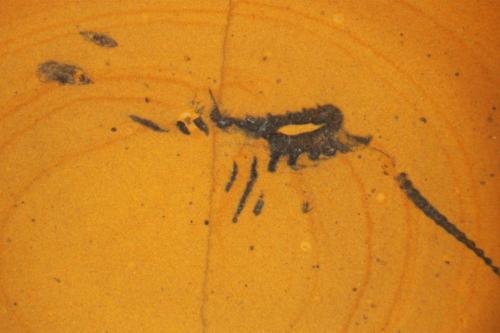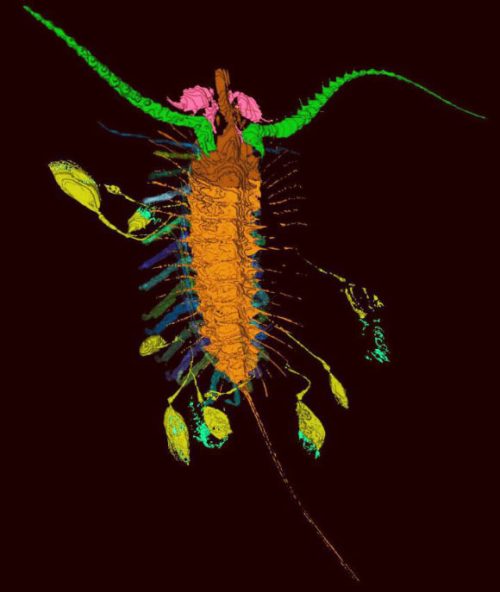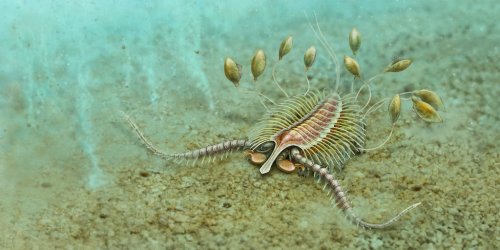A recently described fossil from the Silurian Herefordshire Lagerstätte in the United Kingdom has called much attention.

A photo of the fossil itself. Image by Briggs et al., extracted from news.nationalgeographic.com
The appearance of the creature was build by scanning the rock and creating a 3D reconstruction of the fossil. It revealed that the animal, obviously and arthropod, had several smaller creatures attached by long threads, like kites. The species was named Aquilonifer spinosus, meaning “spiny kite-bearer”.

A 3D reconstruction of what Aquilonifer and its kites would have looked like. Image by Briggs et al. extracted from sci-news.com
The authors (Briggs et al., 2016) thought about three possibilities to explain the unusual “kites”. They could be parasites, phoronts (i.e., hitchhikers), or babies. The idea of parasites was discarded because such long threads separating them from the host would have made it difficult to feed properly. They also considered it unlikely to be a case of phoronts, i.e., a species that uses the host as a mean to move from one site to another, because there were too many of them and the host most likely would have removed them by using the long antennae.

Artistic impression of Aquilonifer spinosus by Andrey Atuchin.
The remaining option is that the kites were offspring. The mother (or father) would have attached them to itself in order do carry them around in a unique mode of brood care. The authors compare it to several other arthropod groups in which some species carry their babies around during their first days. They also consider that the animal could have delayed its molting process to avoid discarding the babies with the exoskeleton.
But can we be sure that this is the case? The entomologist Ross Piper thinks differently. He compares the kites to uropodine mites, in which the juveniles (deutonymphs) attatch themselves to beetles by long stalks in order to be transported from one food source to another. As there are marine mites, that could be the case. He also points out that the kites are scattered through the body, which would make them unlikely to be offspring, as such a distribution would only hinder the parent’s mobility.
Briggs at al. responded to Piper’s critique arguing that marine mites have only recently evolved and that Aquilonifer is very different from a terrestrial beetle. It was most likely a bentonic species, crawling on the ocean’s floor, and not a swimmer, so that it would not be a very good dispersal agent.
What do you think of it? I find it difficult to choose one side. Piper’s comparison with mites is interesting, but only as a way to suggest a convergent evolution. I cannot see how the kites would have been really mites or even arachnids. Now the argument on the kites’ position on the body is a good point. No other group of animals carries their young attached to long stalks spread all over the body. Furthermore, how would the parent properly place the juveniles there? I can only see it as a plausible way if the host were the father and the mother crawled over him to stick the eggs in place. Additionally, couldn’t they be true phoronts that were benefitial to the host? The little fellows could benefit by moving around on the big pal and reaching new food sources while giving protection or other advantage in return. And regarding the delay in molting, I cannot see any evidence that there was any delay. We don’t know how long the kites remained there and perhaps after molting they could simply leave their little houses and build new ones on the host’s new skeleton.
We may never know the truth, but we can keep exchanging ideas.
– – –
References:
Briggs, D., Siveter, D., Siveter, D., Sutton, M., & Legg, D. (2016). Tiny individuals attached to a new Silurian arthropod suggest a unique mode of brood care Proceedings of the National Academy of Sciences, 113 (16), 4410-4415 DOI: 10.1073/pnas.1600489113
Briggs, D., Siveter, D., Siveter, D., Sutton, M., & Legg, D. (2016). Reply to Piper: Aquilonifer’s kites are not mitesProceedings of the National Academy of Sciences, 113 (24) DOI: 10.1073/pnas.1606265113
Piper, R. (2016). Offspring or phoronts? An alternative interpretation of the “kite-runner” fossil Proceedings of the National Academy of Sciences, 113 (24) DOI: 10.1073/pnas.1605909113
Switek, B. 2016. This bizarre creature flew its babies like kites. National Geographic News. Available at < http://news.nationalgeographic.com/2016/04/160404-bizarre-creature-flew-babies-kites-arthropod-fossils-science/ >. Access on July 07, 2016.
